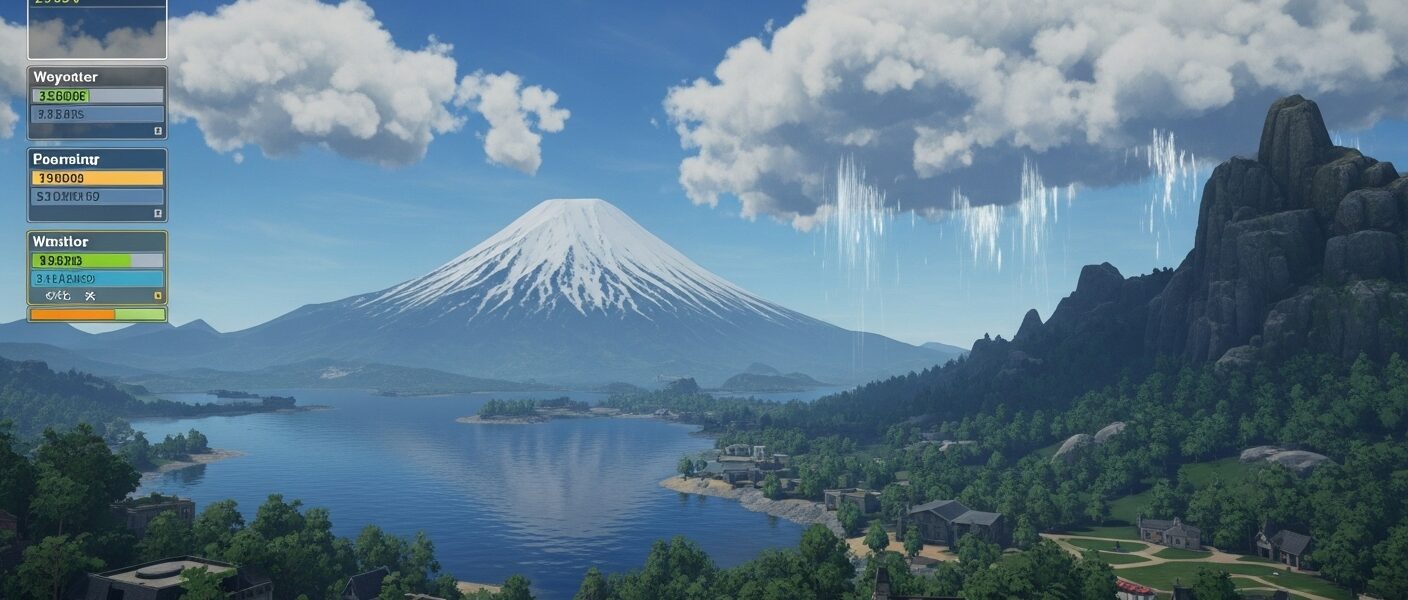Introduction
Video games have always been about immersion. From the earliest days of pixelated adventures to today’s sprawling open-world masterpieces, developers have consistently strived to make players feel like they are truly part of the worlds they explore. One of the most significant ways this immersion has been achieved is through dynamic weather systems. Unlike static environments where the sun is always shining or the rain never stops, dynamic weather systems allow environments to change naturally, creating a sense of realism and unpredictability.
Dynamic weather not only makes a game’s world feel alive, but it also affects gameplay in meaningful ways. A sudden rainstorm may reduce visibility, snow might make travel difficult, or strong winds could alter combat strategies. These systems ensure that no two playthroughs are exactly the same, keeping players engaged and surprised.
This blog will explore the best games with dynamic weather systems, examining how they elevate immersion, impact gameplay, and set new standards for the industry. Whether it is an open-world role-playing game, a realistic racing simulator, or a survival experience, dynamic weather has become a key element in some of the most celebrated titles.
The Importance of Dynamic Weather in Gaming
Before diving into specific titles, it is important to understand why dynamic weather is such a game-changer. At its core, weather systems serve three major purposes in video games:
- Immersion and Atmosphere – Dynamic weather creates believable worlds that feel like living ecosystems. Watching a sunset after a storm or seeing fog roll in at dawn heightens the emotional connection to the environment.
- Gameplay Impact – In some games, weather is more than just visual. Rain might make roads slippery in a racing game, lightning could threaten survival in an open world, and snow might conceal tracks during a hunt. These mechanics add depth and strategy.
- Replayability and Variety – Randomized or changing weather ensures that every session feels different. A familiar area may look and play entirely differently under heavy rain compared to a clear night.
Dynamic weather systems represent the evolution of game design, blending technical innovation with artistic vision to provide players with experiences that feel authentic and memorable.
Best Games with Dynamic Weather Systems
Red Dead Redemption 2
When it comes to dynamic weather, Red Dead Redemption 2 is often the first game that comes to mind. Rockstar Games crafted an environment that is as alive as its characters. The world of the American frontier is filled with breathtaking detail, from thunderstorms rolling across the plains to snowstorms covering the mountains.
What makes Red Dead Redemption 2’s weather system particularly impressive is the attention to detail. Rain not only drenches the landscape but also affects visibility, sound, and even the behavior of animals. Snow accumulates on the ground and changes the way horses move. The wind howls during storms, making players feel as though they are battling the elements. These touches contribute to the sense of realism that makes the game one of the most immersive open-world experiences ever created.
The Legend of Zelda: Breath of the Wild
Nintendo redefined open-world design with The Legend of Zelda: Breath of the Wild, and its weather system was a huge part of that innovation. Unlike many games where weather is purely cosmetic, in Breath of the Wild it directly affects gameplay.
Rain makes climbing surfaces slippery, forcing players to rethink their routes. Thunderstorms pose dangers if players carry metallic equipment, requiring them to adapt their strategies. Snowy environments demand warm clothing or special food to prevent Link from freezing. The ever-changing weather not only adds realism but also forces creativity, ensuring that players are always engaged and challenged by their environment.
Forza Horizon Series
In the world of racing games, the Forza Horizon series stands as a leader in innovation, and its dynamic weather systems are a big reason why. Racing through diverse environments feels exhilarating as weather conditions constantly shift, altering the feel of the road and the visuals of the track.
Rain slicks the streets, creating new driving challenges, while fog can obscure visibility during critical races. Seasonal changes also play a massive role, with snow and ice in winter requiring different strategies than dry summer roads. These weather dynamics transform the driving experience, ensuring that every race feels unique and authentic.
Assassin’s Creed IV: Black Flag
Few games capture the unpredictability of the ocean as effectively as Assassin’s Creed IV: Black Flag. As players take control of Edward Kenway and sail across the Caribbean, dynamic weather plays a central role in shaping the experience.
Calm seas can suddenly give way to violent storms, with towering waves and roaring winds that test navigation skills. These storms not only provide stunning visuals but also serve as gameplay challenges, making naval battles and exploration more intense. The unpredictability of the weather captures the true danger and beauty of life at sea, setting Black Flag apart as one of the best seafaring games ever created.
The Witcher 3: Wild Hunt
The Witcher 3: Wild Hunt is renowned for its storytelling, but its weather system also contributes significantly to its immersive world. Players journey through forests, mountains, and swamps, where the weather changes naturally and seamlessly.
Storms roll in with dramatic skies and pouring rain, while fog creates eerie atmospheres that enhance the game’s darker tone. Snow in Skellige feels harsh and unforgiving, amplifying the ruggedness of the landscape. Although the weather does not impact gameplay as directly as in some other titles, its atmospheric power elevates the storytelling and exploration, making the Continent feel like a living, breathing world.
Grand Theft Auto V
Rockstar’s Grand Theft Auto V also boasts an impressive dynamic weather system. Los Santos, the sprawling fictional city, comes to life under varying weather conditions, from blazing sunshine to thunderstorms that flood the streets.
The weather impacts driving, combat, and the overall feel of the city. Lightning storms add drama to missions, while heavy rain creates slippery roads that challenge driving skills. Although more subtle than in Red Dead Redemption 2, the system contributes to the realism and replayability of the game’s massive open world.
Microsoft Flight Simulator
For fans of realism, Microsoft Flight Simulator stands in a class of its own. Its dynamic weather system is not just simulated but modeled on real-world meteorological data. Players can fly through actual weather conditions happening anywhere in the world, from thunderstorms to hurricanes.
The impact of weather is both visual and mechanical. Turbulence, wind speed, and visibility all play crucial roles in piloting aircraft. This level of realism makes the game not only visually stunning but also educational, giving players a genuine appreciation for the challenges pilots face when navigating unpredictable skies.
Death Stranding
Death Stranding introduced a unique twist to weather systems with its mysterious “Timefall” rain. Unlike ordinary rain, Timefall accelerates the aging of anything it touches, from equipment to the landscape itself. This mechanic is not just a narrative feature but also affects gameplay, as players must prepare and adapt to dangerous conditions.
The constantly shifting weather creates tension and unpredictability in an already surreal world. By blending weather into both story and mechanics, Death Stranding demonstrates the potential of dynamic weather as more than just a background element.
Ghost of Tsushima
Ghost of Tsushima uses its weather system not only for atmosphere but also as a storytelling device. As players journey across feudal Japan, the weather dynamically changes to reflect the tone of the story and the choices made.
Gentle breezes and clear skies enhance moments of peace, while storms build intensity during major battles or story climaxes. The blending of environment, narrative, and gameplay creates a cinematic experience that is enhanced by the unpredictable weather patterns.
Minecraft
Though blocky and stylized, Minecraft’s weather system plays an important role in the sandbox survival experience. Rain, thunderstorms, and snow not only alter the look of the game but also affect gameplay. For example, thunderstorms can summon hostile mobs or even trigger fires with lightning strikes.
Snow alters landscapes and creates unique biomes, while rain can extinguish fires and fill cauldrons. The simplicity of Minecraft’s weather system belies its importance in creating an ever-changing, dynamic environment that encourages creativity and adaptation.
How Weather Impacts Gameplay Design
Dynamic weather systems are more than aesthetic flourishes. In the best games, they are carefully designed to shape player behavior and interaction with the world. For instance, a survival game might use weather to test resource management, forcing players to seek shelter during storms. A racing game might challenge players with wet tracks requiring different handling strategies.
In open-world RPGs, weather often contributes to immersion by mirroring narrative themes or evoking emotional responses. Snowstorms in The Witcher 3 emphasize the harshness of Skellige, while sunny meadows contrast with the dark, war-torn regions.
The most innovative developers use weather as a storytelling tool, gameplay mechanic, and immersive feature all at once. This holistic integration is what makes dynamic weather one of the most exciting elements in modern game design.
The Technical Challenges of Dynamic Weather
Implementing dynamic weather systems is not easy. Developers must balance realism with performance, ensuring that changing conditions do not overwhelm hardware. Creating natural transitions between weather states, such as clouds rolling in before a storm, requires careful programming and artistic design.
Games must also consider the impact of weather on AI behavior, physics, and sound design. Animals fleeing storms, characters reacting to cold, and the muffled sound of footsteps in snow all contribute to the authenticity of the experience. These complexities make dynamic weather one of the most technically demanding features in modern gaming.
The Future of Dynamic Weather in Games
Looking ahead, dynamic weather systems are likely to become even more sophisticated. With the power of next-generation consoles and advanced game engines, developers can create weather that is not only visually stunning but also reactive and systemic.
Imagine storms that evolve organically based on player actions, or ecosystems where weather affects flora, fauna, and resource availability in real time. Cloud gaming and artificial intelligence could allow weather to be simulated globally, reflecting real-world conditions within game worlds.
The future promises even deeper integration of weather into gameplay, storytelling, and immersion, pushing the boundaries of what is possible in interactive entertainment.
Conclusion
Dynamic weather systems represent one of the most remarkable achievements in modern game design. They transform static worlds into living ecosystems, heighten immersion, and add layers of challenge and unpredictability. From the cinematic storms of Red Dead Redemption 2 to the survival challenges of Breath of the Wild and the realism of Microsoft Flight Simulator, weather has become an essential part of how players experience virtual worlds.
The best games with dynamic weather systems showcase the creativity and ambition of developers striving to make their worlds as believable as possible. These systems remind us that video games are not just about mechanics or graphics—they are about creating living, breathing experiences that stay with players long after they put down the controller.
Dynamic weather is no longer just a background feature. It is a defining element of immersive game design, and as technology evolves, it will continue to shape the future of gaming in extraordinary ways.

